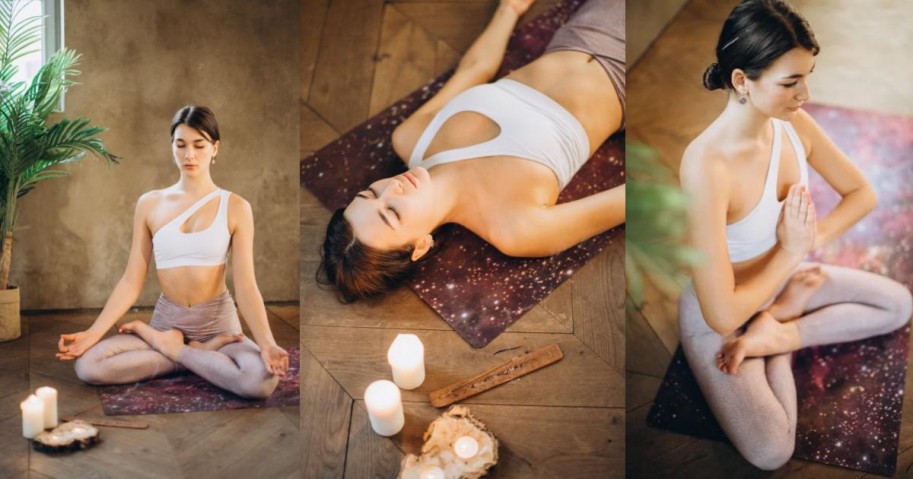
Stress is literally everywhere. Even before the COVID-19 crisis made its way onto the global stage, we've all had things that worry us. And right now, everything seems to be intensified by the pandemic. Keeping ourselves healthy on a wholistic level is important, so we need to keep both our minds and our bodies healthy.
Meditation is an essential part of our health, but it is often disregarded. And contrary to popular misconception, meditation is as not as simple as it sounds. We need to consider a lot of factors, especially those that affect the space where we meditate.
When designing our meditation space, our main objective is to maximize the effect of all elements surrounding us and the experience itself. But where do we start?
Meditation 101: Everything You Need to Know About Creating Your Meditation Space
If you're ready to start a meditation routine, but you're not sure about how or where to start, don't worry--we've got you covered. In this guide, you will find everything you need to know about creating your own meditation space, how the time of day affects your meditation routine, and even how the colors of your surrounding could influence your decisions.
Factors that Affect Your Meditation Space
1. Sound Levels
Any form of noise will distract you from meditating. Controlling the amount of sound that your meditation space can accommodate depends on your sole preference.
How quiet do your surroundings need to be? Do you feel relaxed with music or with the natural noise of birds and nature? Or do you prefer to meditate in a completely silent room?
Whatever your preference is, it is recommended to meditate in a space with less noise. Traffic from the streets, your neighbor's angry dogs, or your kids arguing--whatever the source of the noise is, it needs to be managed as it tends to pull a person out of a meditative space.
It is, therefore, best to soundproof your meditation space from outdoor noise.
2. Time of Day
There is no absolute perfect time of day to meditate. Like the surrounding sound, the time you choose to meditate will be according to your preference. But then, how do you decide whether to meditate in the day or at night? How often would you like to meditate--once a day? Three times a week?
At first, you might think that this is remotely affecting your meditation routine, but this is only slightly true if you live alone. But it is a totally different story if you live with some roommates or your family, especially if we're talking about children.
Considering the time of day when you meditate is especially important if you are juggling a few things. So it is essential to know how your day will flow and when you can concentrate on meditation.
3. Privacy
To this point, we have been emphasizing on the fact that your meditation space needs to be free from distractions. When meditating, you need to be free from anything that will retract you from the "zone."
Therefore, it is important to consider that your meditation space needs to have a door--one that locks. And if it does not lock, you can put up a sign to let your roommates or your family know that you cannot be disturbed. Take note that it is essential for your family to understand that you need the time and privacy for meditation.
If your meditation room has large windows and you personally get distracted from seeing the busy outdoors or maybe your neighbors from the next building, it is recommended that you put up heavy curtains to help you isolate your mind.
4. Space
If you truly value meditation, you won't only make time for it, but you will also make space for it. Your meditation space doesn't need to be expensive or completely new, but all that is important is to make sure that you allocate a space for it.
A guest room is a popular choice, but for some people, it can be a portion of their home office, their physical workout area, the shed, or maybe even a special area in the garage. A does not necessarily have to be 100 percent dedicated to meditation alone if you're considering the limitations but at least dedicate a space for it.
Factors to Consider When Designing Your Meditation Space
Besides the obvious financial investment, there are other things that could help you identify which factors could help boost the effectiveness of your meditation space.
1. Stress
When choosing a space specially dedicated to meditation, be sure that the area is a stress-free zone. Once you walk into the room, take note of how you feel. If you feel relaxed and at peace, then that could be the room for you.
2. Clutter
Before it gets bad, do not let things like "just one box" occupy your meditation space. Even if it is just a small item that does not really occupy a lot of space, it could be the start of what later on turns your meditation space into a storage room.
Keep in mind that in your meditation space, less is definitely more.
3. Natural Vibe
You may have seen some outdoor tranquility gardens--those areas that are seemingly perfect for meditation. This 'perfection' is primarily a result of the combination of natural touches like flowers and some greenery, and the natural sounds and smells from nature.
If a peaceful outdoor area is not available to turn into your meditation space, then it is best to bring some plants in. In general, plants would help detoxify the air you breathe.
4. Seating
Choosing the right seating comes with identifying the purpose of your meditation space. Is it solely for meditation? Or will the room be used for another purpose while you're not meditating?
It is also important to ask who will be using the room. Will it just be you? Or will your family meditate with you? Will you meditate in the room at night based on schedule, so that you can have a family room in the morning?
Whatever the decision is, you need to incorporate this into the choice of seating. What you need to keep in mind is to prioritize user comfort when choosing seats for your meditation room.
5. Elevation
Once again, elevation will matter depending on your preference. Although a lot of people prefer to meditate on the floor using some pillows and cushions, this is not a square requirement.
As needed, you can also use benches, lounge chairs, hammocks, rocking chairs, or swinging chairs.
6. Sound System
Again, whatever sounds circulate within your meditation room matters a lot, and all these would depend on your preference.
While nature is a popular choice, some people also prefer jazz or classical music.
7. Aromatherapy and Candles
Aromatherapy and candles bring a certain type of atmosphere. Because aromatherapy uses essential oils that are basically natural plant extracts, we now circle back to the idea that nature helps keep the mind at peace. Here are some of the most relaxing essential oils that can help reduce stress and anxiety:
Lavender
Jasmine
Lemon
Bergamot
Ylang ylang
Clary Sage
Candles do the same thing--they kind of set the mood for relaxation.
From a more scientific point of view, as humans, we are naturally drawn to the flame of the candle. Because of this, our mind relaxes and settles down.
8. Ventilation
Of course, this is the most important element that you should consider when building your meditation space. Air that is clean, clear, and fresh can help you relax.
Some people use air purifiers and ionizers, which mimick the relaxing effect of feeling the ocean breeze. As a cheaper alternative, you can also simply open the window from time to time to allow fresh air to circulate the room.
9. Color
The common question here is whether one should pick dark colors or light pastel hues. And the only answer to this is that whatever makes you feel comfortable as long as the colors are in harmony. When the colors clash, they do the opposite of the point of having a meditation room, which should be to relax your mind.
10. Lighting
Along with the colors you choose for your meditation space is proper lighting. Similar to the effect of candles, lighting sets the mood for the room.
A good start would be to use a light dimmer instead of a mere on-and-off light switch. This way, you get to adjust the lighting based on your preference and time of day. This is also especially useful when there is more than just one person using the room.
Additionally, you could also use a variety of lighting options--moon lamps, Himalayan salt lamps, and even nature-inspired firefly lights.
11. Digital Influence
Nowadays, our phones, laptops, TVs, and all other gadgets and devices play a huge role in our daily lives. But this does not mean that they should also occupy a part of your meditation space.
Chances are, these gadgets will distract you from the meditative state as they will only remind you of work and other responsibilities. So it is best that for those few minutes or hours that you decide to meditate in a day, these digital distractions are far from reach.
This could be particularly difficult when your meditation space doubles as a home office. In this case, what you can do is cover any screens while you meditate. Although not a pretty sight, you can use naturally woven cloths to cover them up. Also, make sure that your phones are on silent mode and they are far from you.
12. Personalization
Finally--and basically what this entire article has been repeatedly emphasizing--be sure to keep in mind that your meditation space is your personal space. So along with prioritizing relaxation, the elements in your meditation space need to be according to your taste and preference.
What matters is that all the elements in your meditation room promote calmness.













